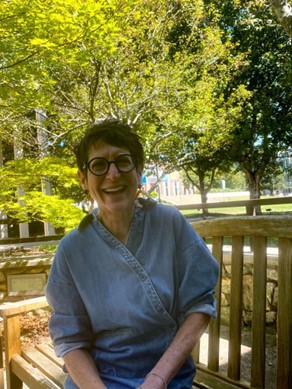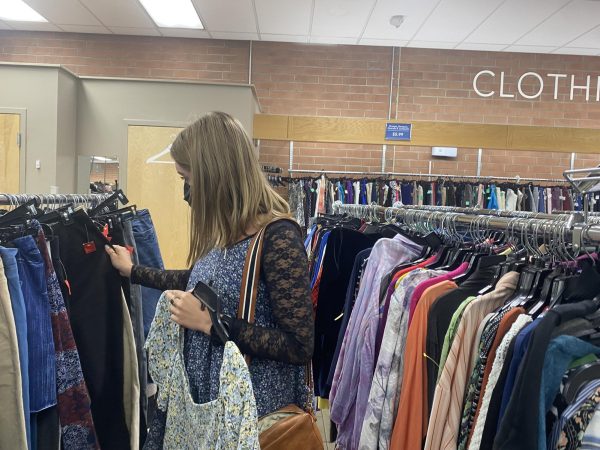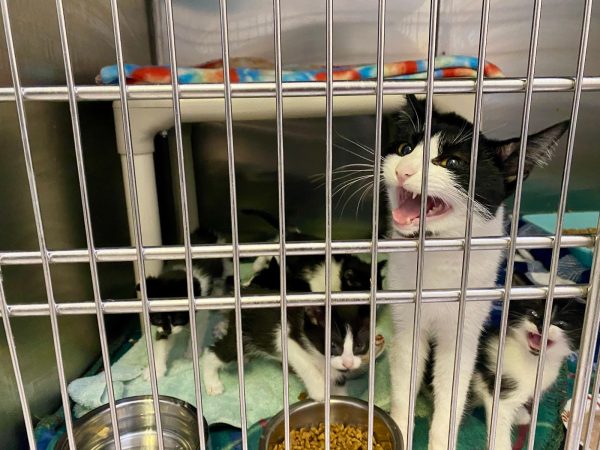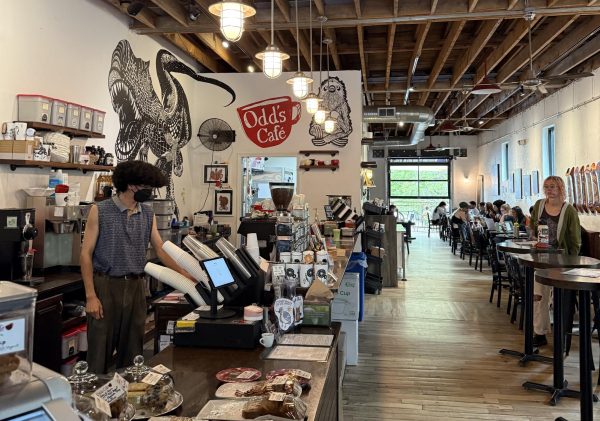Collard greens and gefilte fish: Marcie Cohen-Ferris writes a new voice in food studies

Marcie Cohen Ferris spoke at UNC Asheville for their Farm-to-Table dinner and a handful of talks and lectures.
It was chilly enough to require pants and long sleeves to sit on the patio outside of Karpen Hall. The tent from the Sept. 28 Farm-to-Table dinner still stood tall, still reminiscent of the chill which wiped out the crowd. Marcie Cohen-Ferris, a thin woman clad in a button over denim dress and distinctive circular, navy blue glasses, sat in a wooden chair facing the quad and perfectly placed in a natural spotlight, who needs a stage?
Marcie, a professor emeritus at UNC Chapel Hill and a prolific food studies writer, joined students and faculty for a discussion on food studies and her years of experience teaching and writing.
“Food studies as a field was a developing field and when I went to Chapel Hill, I didn’t teach a food studies course for a couple of years,” Ferris said. “I was teaching what it meant to understand American space through the lens of food. Finding other colleagues doing food in their own fields, there wasn’t really anybody in my department, it was a lot of older guys that thought it was funny. They couldn’t believe I was overseeing masters students in folklore who were writing about food.”
She turned her head to the circle of 17 attendees and begged an answer as to why this field was interesting personally. Some declared a deeper connection to their own cultures and others were interested in the writing itself.
Marcie’s passion for food arose during her childhood, being fascinated by literature about food preparation and watching her mother cook. She said her mother often showed the labor of cooking but was surprised when Marcie wanted to make her own challah. Her mother started letting Marcie into the kitchen to explore this interest.
Food itself is a looking glass into culture and often one’s place within that culture. Ferris said her mother’s expression in her food is both traditional and familiar.
“Jewish women’s history comes out of that and pretty much becomes its own field,” Ferris said. “The place of Jewish food and Jewish women’s creativity and how they choose to use food, to hold families together, to create community, or to raise money for their Jewish community. In the past they owned women of color, they were complicit in the wrongs of our region. It speaks to the power of the intersection between women, home, food, the synagogue, the workplace or the grocery store, Jewish women’s experience connects to that.”
Geri Gerwinkel-Gershon, Jewish lifelong engagement director at the Asheville Jewish Community Center, said that holidays are observed in various ways. Gerwinkel-Gershon has been involved in the Asheville Jewish community for over 20 years and hosts a podcast for the JCC called J Voices where she and her co-host Michaela Kelley ask questions about Jewish life in Asheville and beyond.
“Rosh Hashanah is a synagogue oriented holiday,” Gerwinkel-Gershon said. “We support others in providing a place to celebrate or to observe the holiday. I do mostly education and helping people find connections for Rosh Hashanah but, for instance, we have a couple holidays coming up. Simchat Torah we’ll be celebrating here and bringing the entire Jewish community to our building.”
The Asheville Jewish Community Center serves as a resource for Asheville and stands as an institution to strengthen Jewish identity, celebrate Jewish culture and build an inclusive community.
As Rosh Hashanah passed before Ferris’ time in Asheville, she discussed the food of the season. Throughout Ferris’ writings, she has noted southern twists in Jewish food such as late summer produce in North Carolina featured on the table and local fish used to interpret dishes such as gefilte fish.
“I think it’s been shaped by the history of the South, by the forces of colonization, by white supremacy,” Ferris said. “Codes in our region have shaped the production, presentation and the choices that surround Jewish food in the South. Local ingredients impact, seasons impact, I’ve seen people incorporate late summer foods into their holiday meals, fresh lima beans, fresh field peas with their roasted chicken and challah.”
Decorating for Rosh Hashanah typically features apples, pomegranates, honey and whatever else the heart desires. Marcie’s mother brought out the nicest of their china, polished the silverware and had the linens pressed. Running around tweaking decorations at the last minute is a rush that is unparalleled in Marcie’s book.
“My mother would prepare for weeks in advance, freezing honey cake and pound cake,” Marcie said. “She would have people over to the house because we lived in northeastern Arkansas where people would come from over little towns to the synagogue in our little town. During the afternoon of Yom Kippur, you would take a break between the morning and evening services and people were fasting. After we broke the fast at the temple, because the temple was our community center, we were small but mighty.” She grinned and raised her arm in a strong man pose.
The big day of breaking the fast brought in the entire family with a spread of dishes, all lovingly prepared. The food was nothing short of delicious.
“She would do a jello for the first course,” Marcie said. “A beautiful blackberry jam with a sour cream layer in the middle and berries and nuts. It was delicious, still is. Everybody would be served a plate and there would be an orange honey chicken and a kugel, she made this spinach casserole that probably had a can of soup in it but it was so good.”
While she may have not been living in the south while she grew up, Marcie takes in the southern interpretations of classic foods.
“My mother wasn’t southern so she didn’t incorporate those things but I saw other southern Jewish cooks that were born in the region do that,” Ferris said. “That means at Jewish holidays I see my friends set their tables with palm fronds and it looks like the Lowcountry. It will taste like the Lowcountry, they’ll use local fish to make gefilte fish and serve a roasted fish for their main course. Some of the traditional foods have shifted, they’ll always have rice because it’s Lowcountry.”
Marcie ran with these experiences and memories, leading her to places like Williamsburg where she studied at George Washington University.
“I worked in public history museums and in agricultural museums and food is at the heart of them,” Marcie said. “I started getting involved in foodways, I worked in folklore and outdoor museums. I really started to see this passion. I kept moving toward food and how they interpreted food at Colonial Williamsburg. When I was doing my doctoral work at George Washington I thought I should write about the south and being Jewish and my world.”
Museum work in all respects requires knowledge. Hillary Schroeder, the assistant curator at Asheville Art Museum, has spent her higher education in Renaissance and performance art and now considers herself an enthusiastic generalist.
“I like working with people and the public and I feel like museum work is a great opportunity to continue learning all the time on your own and also help others experience art,” Schroeder said. “What’s the point of art if people don’t get to enjoy it? I never stop at this job, it’s the coolest.”
Asheville Art Museum currently features Rebel/Rebelle, an exhibition in partnership with the Rubell museum in Florida. Schroeder said theexhibit stemmed out of feminist interest in contemporary art.
“We had adjacent interests in feminism and feminist art as our educational and scholarly histories. It seemed like a fun collection to pull from for that purpose,” Schroeder said. “It’s never not a timely discussion and I think has become all the more important in the world around us and a lot of these different movements in place are intersectional with one another. Feminism as a movement is desperately in need of an update and that’s an idea we tried to work into this collection.”
Ferris saidher voice in food studies has been marginalized but she calls out the rigidity.
“Now, as we’re seeing another circle of time where we are experiencing racial division and rising nationalism and violence,” Ferris said. “It’s really important to me to have a voice. What often happened in the past was heightened fear and anxiety in Jews, immigrants and people of color. The Jewish response was to underground, keep a low profile and assimilate as much as possible. Don’t look Jewish, don’t act Jewish, don’t eat Jewish, don’t talk Jewish, just try to fade into whiteness.”
The waves of feminism and intersectionality crop up in various social settings. Ferris saw how her voice was taken lightly when she discussed researching food and how women’s labor in food is often seen as a requirement.
“I think there’s a little conversation on whether we’re in a fourth wave or not but I feel like we’ve moved into a new conversation about it in the past 5 to 10 years because there’s been criticism in feminist thought and movements being pretty exclusionary,” Schroeder said. “It’s been focused on mainly the experiences of white women but ultimately, I think, it’s about the idea of greater equality and equity for everyone. The movement is catching on to that, it’s becoming more expansive and not limited to the experience of cis white women. I think that’s where the conversation is right now, what does an intersectional feminist look like?”
The beauty in food and the culture that surrounds it is more than prevalent in Ferris’ life in the past, present and future.
“My mother prepared for the Jewish high holidays in a beautiful way,” Ferris said. “As kids we were a part of the preparation ritual, we would cook and the house would smell delicious, she would write down what our menus were going to be. She took the time to do it beautifully. She would have the linens pressed, silverware polished, she would pull out the special china, there’s something about watching the labor that it took that was so transformational for me as a little girl.”



















